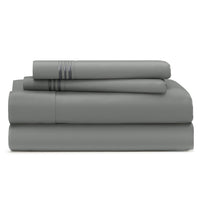
Choosing the Perfect Bedroom Color Palette
A well-designed bedroom serves a bigger purpose than just looking good. It promotes better rest, success, happiness, and overall togetherness in your life. No pressure, right?
It doesn’t need to be overwhelming. If you’re looking to spruce up your bedroom, or completely revamp it, the best way to start is to find a color palette that speaks to you.
Color has power. It’s used to evoke emotions, moods, and tell a story. The colors of a space reflect how you feel in that space. From clean neutrals to bold and beautiful colors, you can easily transform how you feel in your bedroom.
Who knew colors can emote so much?

Before You Start
Before you start throwing paint onto your walls and buying décor, there are a couple of things you should keep in mind when choosing your bedroom color palette.
Tip #1 - Choosing a Scheme
There are 3 different types of color schemes you can choose from: Analogous, Complementary, and Monochromatic.
Analogous involves choosing 3 or more colors that are next to each other on the color wheel. One of the colors will be the dominant hue, while the others work as secondary or accent colors. Think of it as a gradation of color.
Complementary colors are opposites of each other on the color wheel. Complementary colors allow you to play around with a variety of colors, while still making the room cohesive. The results are eye-popping and contrasting.
Monochromatic uses a single color, but in a variety of hues and tones. This creates a sophisticated and relaxing vibe. When using a single color like this, playing with patterns and textures for décor can be fun and add personality to the space.

Tip #2 - Work With Natural Light
When choosing the colors of your bedroom, working with the natural light coming in can help you choose between warm and cool colors.
Cool colors, such as blue, green, gray, and purple absorb the light. This can make the room feel cooler and, in some cases, more spacious. If your bedroom is bright and sunny, choosing cool colors will balance the light. If your bedroom gets minimal natural light, they can give it a moody feel. Cool colors typically work best because they can create a relaxing and calming environment.
Warm colors, such as brown, beige, orange, etc. reflect light, making your room feel warmer and cozier. If your bedroom gets minimal natural light, warm colors can add life to your space. On the other hand, if your room gets a lot of natural light, they will make the room feel even brighter and uplifting.
Tip #3 - 60-30-10 Rule
This rule can help guide you in deciding on room décor, as well as painting your space. The rule is very simple:
- 60% of the space will be the main color (this is typically the more neutral color of the palette)
- 30% of the space will be the secondary color (the medium/bolder shade of the palette)
- 10% of the space will be the accent color (the boldest shade of the palette)
This rule can especially be helpful if you are using dark colors in your bedroom palette. Dark colors can make your space feel cozier if it is a large space since dark colors typically make a space seem smaller and more intimate.

Tip #4 - Forget What’s Trending
We know, this tip sounds crazy, but hear us out. If what colors are trending speak to you, then by all means choose those colors. However, it is always important to remember that this is YOUR bedroom and YOUR sanctuary.
Choose a color that you love and you can live with for a long time. If you’re unsure, test the colors with either paint swatches or fabric samples. A color you might like in the store may look completely different in your lighting at home.
So go bold, moody, or neutral — it is completely up to YOU!
Bedroom Color Palette Inspiration
Whether you’re looking to paint your whole bedroom, an accent wall, or find the perfect sheets and décor, creating your bedroom oasis can be a fun process. The possibilities are endless!
There are SO many different palette options you can choose from, but we’re going to outline a couple of our favorites.

Neutrals
Neutrals are a great, safe choice since they are so versatile. Colors like white, beige, and tan bring balance to the room and don’t have much of an impact on mood. This makes neutrals also a great option if you’re decorating a guest room.
The Vibe: Light, Clean & Crisp, Calming — especially if there is a lot of natural light coming in.
Complementary Colors: Generally supports all colors
How to Make it Work: Decorate using textures and patterns to add a little bit of character to the room.

Sage Green
Classical, earthy, and minimalistic — sage green is becoming a very popular color choice. It is a pop of color that isn’t too bold. It can tone down brighter accent colors or add life to some neutral colors.
However, sage green is more than just aesthetically pleasing. It provides a calming effect and gives a room the feeling of space and relaxation. Think of it as how a house full of plants can relax you (but without the added maintenance).
The Vibe: Earthy, Serene, Spa-like
Complementary Colors: White and gray. A muted red. Yellow. Dusky pink.
How to Make it Work: Natural finishes, houseplants. Use it as an accent wall or as your main color for your décor.

Burgundy
Red can be a difficult color since it is stimulating and powerful. However, if you’re wanting that bold look, a muted burgundy is the perfect color to go with for your bedroom.
While burgundy is a great color choice for a bedroom, it might be best to use the color sparingly or complement it with more muted colors. This is due to the fact that any shade of red carries a lot of energy and can be overstimulating and cause irritability when trying to go to sleep. When used correctly, burgundy can make a room feel warm and cozy.
The Vibe: Comfort, Passionate, Powerful, Bold & Daring
Complementary Colors: Neutrals, Black, Navy blue, Brown, Green, Gold
How to Make it Work: Use as an accent wall, or as an accent color for décor.

Silver
Silver can be incorporated into a bedroom palette in a variety of ways. It adds just enough metallic and edge to give your bedroom a whole new feel.
Since silver is in the gray family, no matter what color you choose to accent the room, it’ll still be eye catching. It is also a great foundation color if you’re someone who loves to decorate per season or holiday.
The Vibe: Clean, Sophisticated, Modern
Complementary Colors: Typically depends on the shade of silver, but generally silver supports all colors.
How to Make it Work: Mix and match elements and tones, use silver as décor and accent pieces, or find a fun silver wallpaper to add texture or patterns.

Dark Teal
This deep, blue-green shade can easily transform your bedroom into a relaxing oasis. Dark teal is a great bedroom color because it is more versatile than you would think — it’s modern, yet retro. Tropical, yet sophisticated. Relaxing, yet eclectic and edgy.
This also means you can transform your bedroom with either warm colors or cool colors. Dark teal can go with so many different colors and shades, so it is a color you can have fun with when it comes to decorating your bedroom.
The Vibe: Calming, Lush, Moody, Unique
Complementary Colors: White, Black, Gray, Purple, and more — it all depends on if you want to go with a cool or warm bedroom.
How to Make it Work: If your bedroom is smaller, go with dark teal and lighter colors so it seems more open. If you’re looking to fill space, choose a darker shade to go along with the dark teal.

Chocolate
While many may think of chocolate brown as a color for accent pieces and furniture, the color can actually be a great choice for the main aesthetic for your bedroom.
Your bedroom should feel relaxed and comfortable, and chocolate brown is a great color to achieve that. Many many think chocolate brown is a boring color, but since it is so versatile life can easily be added to what some consider a “lackluster” color.
The Vibe: Cozy, Romantic, Warmth, Rustic
Complementary Colors: Generally supports all colors
How to Make it Work: Add patterns and textures, decorate with neutral colors for a lighter feel or darker accent pieces for a moody, cozy feel.
Once you have nailed down what feeling or energy you want for your bedroom, use that color as your starting point. Let it influence your choice of furniture, fabrics, paint, and accent pieces to create the atmosphere you desire most.
You don’t have to do a complete design overhaul to have the ideal ambiance in your bedroom. Simply updating the color of your linens, hanging plants, or adding rugs and small décor pieces could be enough to do the trick!
If you’re looking to incorporate your favorite colors more subtly, be sure to check out our Cosy House Luxury Bamboo Bed Sheets. We offer them in 13 colors, including the colors mentioned above!
We've gone ahead & enclosed a 10% off coupon below for you to use if you'd like to take the plunge and try out our sheets for yourself! To shop our collection & get 10% OFF Use the code 'BLOG10' at checkout.


